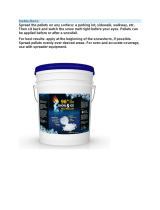
Dear Customer,
Thank you for having chosen one of our products, which is the result of years of experience and continuous research aimed at making a superior
product in terms of safety, reliability and performance.
This booklet contains information and advice for safe and efcient use of your product.
IMPORTANT INFORMATION
The following symbols are used in some parts of the booklet:
a CAUTION: for actions that require particular caution and
suitable preparation.
d FORBIDDEN: for actions that UNDER NO CIRCUMSTANCES
must be carried out.
a Contact local building authority (such as municipal building
department, re department, re prevention, bureau. etc.)
before installation to determine if a permit and/or inspection
is required.
• This instruction booklet has been prepared by the manufacturer and is
an integral part of the product. In the event of sale or relocation of the
product make sure this booklet accompanies it, since the information
contained in it is intended for the purchaser and for anyone involved
in the installation, use and maintenance of the product.
• Read the instructions and the technical information contained in
this booklet carefully before proceeding with installation, use or any
repairs.
• The observance of the instructions and technical information in this
instruction booklet guarantees the safety of persons and property; it
also ensures more efcient operation and an increased lifespan.
• Gruppo Piazzetta S.p.A. cannot be held responsible for damage or
injury due to failure to comply with the instructions for installation,
use and maintenance given in this booklet, or due to unauthorised
alterations or to the use of other than original spare parts.
• Appliance installation and use must conform with the manufacturer’s
instructions as well as with European and national legislation and
local regulations.
• Installation, electrical connection, checks, maintenance and repairs
are operations which must be carried out exclusively by qualied and
authorised personal with specialised knowledge of the product.
• The wall against which the product is to be placed must not be of
wood or any other ammable material. For correct installation it is
also important to comply with the section entitled “MINIMUM SAFETY
DISTANCES”.
• Before installing the product read all instruction booklets relevant to
the cladding, the ventilation kit and any other accessory.
• Check that the oor where the product is to be installed is perfectly
level.
• When handling the steel parts of the cladding it is advisable to use
clean cotton gloves to avoid leaving ngerprints that are difcult to
remove at rst time of cleaning.
• The stove must be assembled by at least two persons.
See the guarantee certicate enclosed with the product for the terms, limitations and exclusions.
In line with its policy of constant product improvement and renewal, the manufacturer may make changes without notice.
This document is the property of Gruppo Piazzetta S.p.A.; no part of it may be disclosed to third parties without the written permission of
Gruppo Piazzetta S.p.A. All rights reserved by Gruppo Piazzetta S.p.A..
• Connect the pellet stove to the electricity supply only after it has been
connected by an expert to the ueway.
• The plug at the end of the power cable must be easily accessible after
installation.
• Use only recommended wood pellets in the pellet stove (refer to
section entitled “FUEL”).
• Never use liquid fuels to light the pellet stove or to relight the embers.
• Ensure that the area where the stove is installed is properly ventilated
while the stove is lit.
• In the event of malfunctioning the fuel supply will be stopped. Restart
the stove only after having eliminated the cause of the malfunction.
• Stop using the product in the event of fault or malfunctioning.
• Do not remove the protective grille from the pellet hopper.
• Any build-up of unused pellets in the burner left over from repeated
failed ignitions must be removed before attempting to light the stove
again.
• Stove operation can result in surfaces, handles, ue pipe and glass
becoming extremely hot. When the stove is in operation, only touch
these parts if wearing protective clothing otherwise use suitable tools.
• Because of the build-up of heat on the glass, take care that those who
are unfamiliar with stove operation do not linger near the stove.
• This appliance must not be used by persons (including children) with
reduced physical, sensory or mental capacities, or lack of experience
or knowledge unless they are supervised or instructed on use of the
appliance by the person who is responsible for its safety.
• Creaking may be heard while the stove is in operation or cooling
down. This is not to be considered a defect, but is a consequence of
thermal expansion of the component materials.
• The product you have purchased may different slightly from the one
illustrated in this booklet since the pictures are only given as an
indication and not an exact portrayal.
a In the event of difculties or if you are unable to understand
the instruction booklet, contact your local dealer.
d Do not place objects which are not heat-resistant on top of
the stove or within the recommended minimum safety area.
d Do not open the door while the stove is in operation or operate
the stove when the glass is broken.
d In case of any alarm signals do not unplug the stove: just turn
the unit OFF.
H07032120 / DT2002308 – 00
2
English
DT2010208-08
DT2010001-01






















